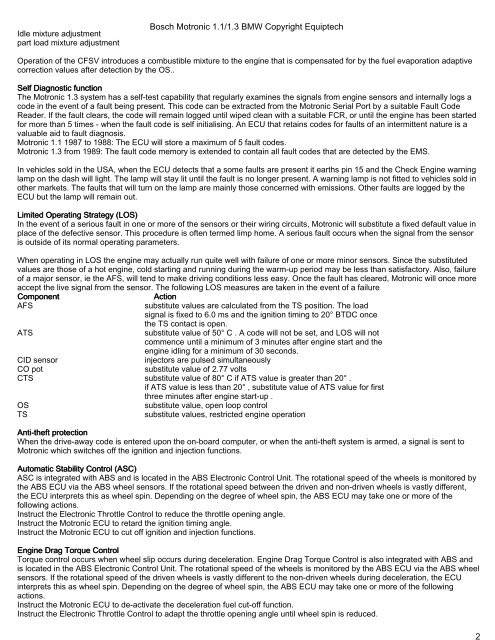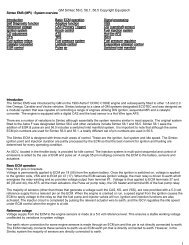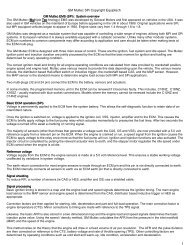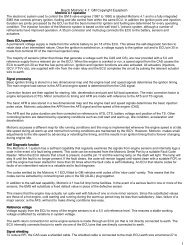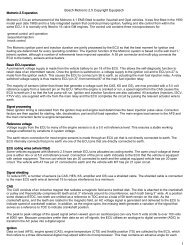You also want an ePaper? Increase the reach of your titles
YUMPU automatically turns print PDFs into web optimized ePapers that Google loves.
2<br />
Idle mixture adjustment<br />
part load mixture adjustment<br />
Bosch Motronic <strong>1.1</strong>/1.3 BMW Copyright Equiptech<br />
Operation of the CFSV introduces a combustible mixture to the engine that is compensated for by the fuel evaporation adaptive<br />
correction values after detection by the OS..<br />
Self Diagnostic function<br />
The Motronic 1.3 system has a self-test capability that regularly examines the signals from engine sensors and internally logs a<br />
code in the event of a fault being present. This code can be extracted from the Motronic Serial Port by a suitable Fault Code<br />
Reader. If the fault clears, the code will remain logged until wiped clean with a suitable FCR, or until the engine has been started<br />
for more than 5 times - when the fault code is self initialising. An ECU that retains codes for faults of an intermittent nature is a<br />
valuable aid to fault diagnosis.<br />
Motronic <strong>1.1</strong> 1987 to 1988: The ECU will store a maximum of 5 fault codes.<br />
Motronic 1.3 from 1989: The fault code memory is extended to contain all fault codes that are detected by the EMS.<br />
In vehicles sold in the USA, when the ECU detects that a some faults are present it earths pin 15 and the Check Engine warning<br />
lamp on the dash will light. The lamp will stay lit until the fault is no longer present. A warning lamp is not fitted to vehicles sold in<br />
other markets. The faults that will turn on the lamp are mainly those concerned with emissions. Other faults are logged by the<br />
ECU but the lamp will remain out.<br />
Limited Operating Strategy (LOS)<br />
In the event of a serious fault in one or more of the sensors or their wiring circuits, Motronic will substitute a fixed default value in<br />
place of the defective sensor. This procedure is often termed limp home. A serious fault occurs when the signal from the sensor<br />
is outside of its normal operating parameters.<br />
When operating in LOS the engine may actually run quite well with failure of one or more minor sensors. Since the substituted<br />
values are those of a hot engine, cold starting and running during the warm-up period may be less than satisfactory. Also, failure<br />
of a major sensor, ie the AFS, will tend to make driving conditions less easy. Once the fault has cleared, Motronic will once more<br />
accept the live signal from the sensor. The following LOS measures are taken in the event of a failure<br />
Component<br />
AFS<br />
ATS<br />
Action<br />
substitute values are calculated from the TS position. The load<br />
signal is fixed to 6.0 ms and the ignition timing to 20° BTDC once<br />
the TS contact is open.<br />
substitute value of 50° C . A code will not be set, and LOS will not<br />
commence until a minimum of 3 minutes after engine start and the<br />
engine idling for a minimum of 30 seconds.<br />
CID sensor<br />
injectors are pulsed simultaneously<br />
CO pot<br />
substitute value of 2.77 volts<br />
CTS substitute value of 80° C if ATS value is greater than 20° .<br />
if ATS value is less than 20° , substitute value of ATS value for first<br />
three minutes after engine start-up .<br />
OS<br />
TS<br />
substitute value, open loop control<br />
substitute values, restricted engine operation<br />
Anti-theft protection<br />
When the drive-away code is entered upon the on-board computer, or when the anti-theft system is armed, a signal is sent to<br />
Motronic which switches off the ignition and injection functions.<br />
Automatic Stability Control (ASC)<br />
ASC is integrated with ABS and is located in the ABS Electronic Control Unit. The rotational speed of the wheels is monitored by<br />
the ABS ECU via the ABS wheel sensors. If the rotational speed between the driven and non-driven wheels is vastly different,<br />
the ECU interprets this as wheel spin. Depending on the degree of wheel spin, the ABS ECU may take one or more of the<br />
following actions.<br />
Instruct the Electronic Throttle Control to reduce the throttle opening angle.<br />
Instruct the Motronic ECU to retard the ignition timing angle.<br />
Instruct the Motronic ECU to cut off ignition and injection functions.<br />
Engine Drag Torque Control<br />
Torque control occurs when wheel slip occurs during deceleration. Engine Drag Torque Control is also integrated with ABS and<br />
is located in the ABS Electronic Control Unit. The rotational speed of the wheels is monitored by the ABS ECU via the ABS wheel<br />
sensors. If the rotational speed of the driven wheels is vastly different to the non-driven wheels during deceleration, the ECU<br />
interprets this as wheel spin. Depending on the degree of wheel spin, the ABS ECU may take one or more of the following<br />
actions.<br />
Instruct the Motronic ECU to de-activate the deceleration fuel cut-off function.<br />
Instruct the Electronic Throttle Control to adapt the throttle opening angle until wheel spin is reduced.


